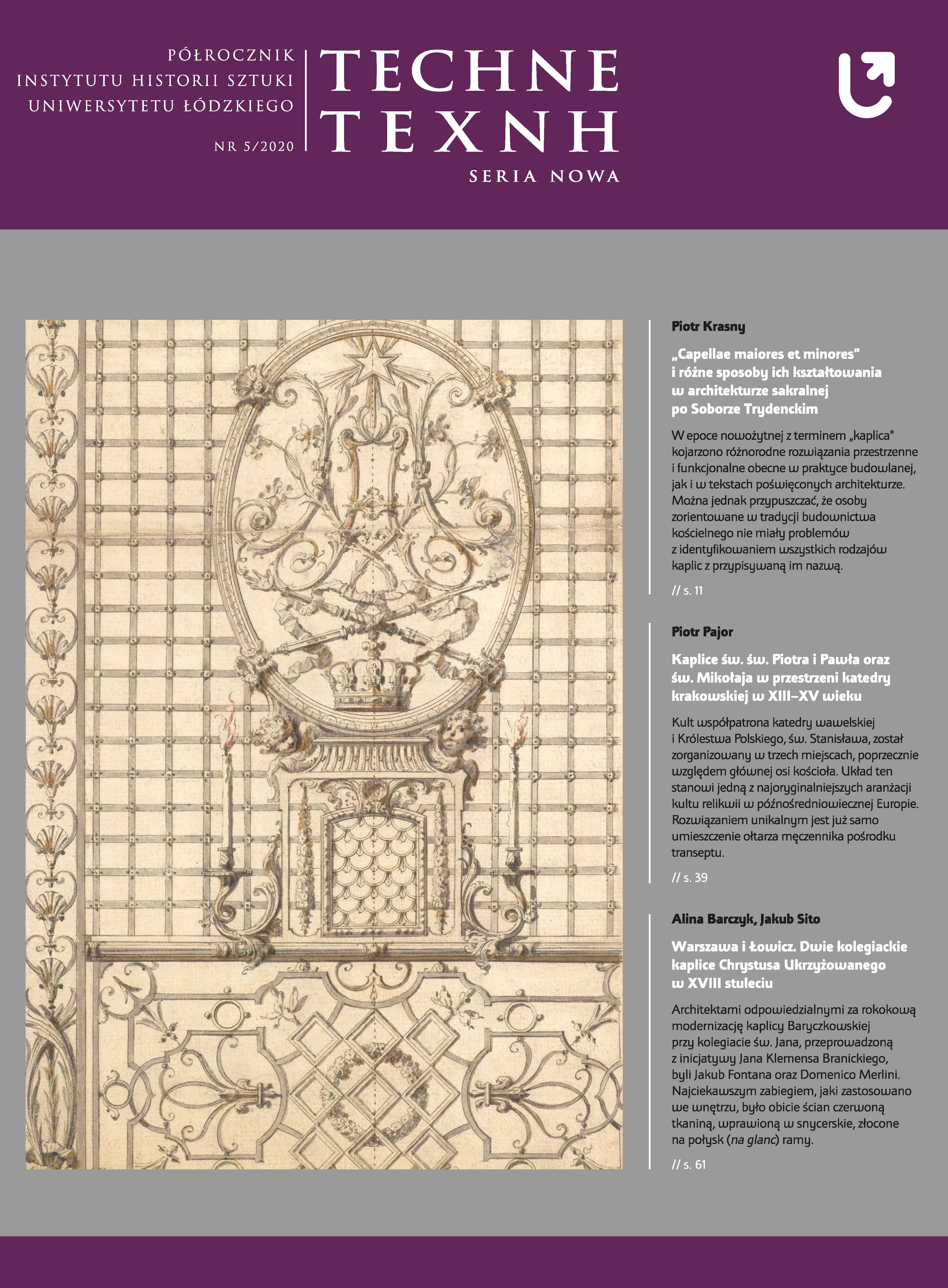St. Mary Magdalene and St. Stanislaus Basilica in Szczepanów – from the gothic “Długosz” church to the twentieth-century double church
DOI:
https://doi.org/10.18778/2084-851X.09.08Keywords:
patronage of Jan Długosz, Szczepanów, gothic churchAbstract
In Szczepanów, the alleged birthplace of St. Stanislaus and the later center of his cult, a brick and stone gothic church was erected in 1470. Previously, there were two wooden churches built one after another. The brick church was built due to the progressive degradation of the structure of the old temple. The church funded by Jan Długosz is an example of a gothic sacral building with perfectly selected proportions and an extremely harmonious combination of architectural forms. It is also the result of a well-thought-out composition program, based on the geometrical relationships of the basic figures: a triangle and a square. The church is in fact a miniature equivalent of a gothic cathedral containing adequate architectural elements, whose artistry and perfection are expressed in ideal proportions of the whole and contrasting size ratios of individual forms.
The gothic church had one rectangular nave covered with a wooden beam ceiling and a narrower presbytery with a rib vault, closed with a hexagon. Two entrances led to the nave – direct from the west and from the south, through a square porch. An elongated rectangular sacristy with a cross vault adjoined the northern wall of the presbytery. The nave and the presbytery were covered with a slender, gabled roof, flanked by soaring gables of brick walls over the nave, while over the eastern end of the presbytery it was closed with three additional triangular slopes. The porch and the sacristy were covered with shed roofs led just up to the brick cornices of the temple.
The church functioned unchanged for almost a century and a half, until 1610. At that time, a chapel was built on the northern side of the nave. Its outline with three buttresses, visible in a drawing by Władysław Łuszczkiewicz from 1893, indicates that it was a late Gothic structure, although it was built in modern times. The chapel added to the church, did not suppress the original architectural form and did not change the existing functional layout of the building. It was possible thanks to the addition of the gothic structure to the windowless northern wall of the nave.
Another reconstruction, probably made in the 17th century, was related to the transformation of the existing porch into a chapel. At that time, the southern portal was walled up, and a small semicircular window was carved on the eastern side. The stonework of the internal portal was also removed, making a wider arcade here. As the western entrance to the church was insufficient, a new porch was added from the north side of the western span of the existing chapel.
A radical reconstruction of this sacral complex took place at the beginning of the 20th century. At that time, the northern chapel with the adjacent porch and sacristy were torn down. From this side, next to the gothic church, a much larger neo-gothic “cathedral” with a basilica layout appeared, modularly and stylistically referring to the gothic building. The former church of St. Mary Magdalene has become a separate chapel, functionally incorporated into the layout of the new temple through doubled arcades made in the northern gothic wall and an annex in the place of the gothic sacristy, which connected the gothic chancel with the new one. The sacral complex shaped in this way acquired the character of a double church, an integrated form, but not devoid of separate features.
References
BIELAK 2011 – Włodzimierz Bielak, Jeszcze w sprawie factum biskupa krakowskiego Stanisława ze Szczepanowa, „Nasza Przeszłość”, t. 115–116, Kraków 2011, s. 161.
Google Scholar
CZECHOWICZ 2018 – Jacek Czechowicz, Rozbudowa świątyni. Nowa przestrzeń sakralna na kanwie dawnego układu wybranych kościołów Małopolski, Kraków 2018, s. 132–169.
Google Scholar
ŁUSZCZKIEWICZ 1868 – Władysław Łuszczkiewicz, Zabytki dawnego budownictwa w Krakowskiém, z. 5, Kraków 1868.
Google Scholar
ŁUSZCZKIEWICZ 1880 – Władysław Łuszczkiewicz, Budowle Długosza, „Kłosy”, t. 31, nr 786, Warszawa 1880, s. 60.
Google Scholar
MRÓZ 2003 – Franciszek Mróz, Geograficzny zasięg kultu św. Stanisława w Polsce, [w:] Skałka – Sanktuarium i Panteon Narodu 750-lecie kanonizacji św. Stanisława Biskupa i Męczennika, „Peregrinus Cracoviensis”, red. Ludwik Kaszowski, z. 14, Kraków 2003, s. 110–111.
Google Scholar
RAJMAN 1993 – Jerzy Rajman, Przedkanonizacyjny kult św. Stanisława biskupa, „Nasza Przeszłość”, t. 80, Kraków 1993, s. 48.
Google Scholar
Sprawozdania – „Sprawozdania z posiedzeń Komisji historji sztuki”, Warszawa–Kraków 1921, s. 23.
Google Scholar
SZYDŁOWSKI 1919 – Tadeusz Szydłowski, Ruin Polski, Kraków 1919, s. 49.
Google Scholar
Downloads
Published
How to Cite
Issue
Section
License

This work is licensed under a Creative Commons Attribution-NonCommercial-NoDerivatives 4.0 International License.








